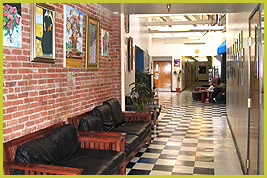 |
 |
 In February 2001, through a grant from The California Endowment (TCE), a collaborative of community-based organizations in Los Angeles embarked on replicating a unique program, the Community Model, to break the cycle of homelessness for mentally ill adults—the most visible and needy on the street. In February 2001, through a grant from The California Endowment (TCE), a collaborative of community-based organizations in Los Angeles embarked on replicating a unique program, the Community Model, to break the cycle of homelessness for mentally ill adults—the most visible and needy on the street.
The Community Model has been patterned after a highly effective program pioneered by Lamp Community, one of the collaborative members. Located in the Skid Row area of downtown Los Angeles, home to several Single Room Occupancy (SRO) hotels and just blocks from its business district, Lamp Community’s approach has proven worthy of replication and successful in engaging, serving, and housing this hard-to-reach population.
 |
|
Lamp Community’s Village facility is quite large. Besides its residential and service programs, it houses Village Industries, a cluster of small businesses providing needed services for the downtown neighborhood, as well as a source of job training and employment for Lamp Community members. |
The Community Model employs various housing strategies and offers an array of employment, recovery, and supportive services, all under a “no-fail, high tolerance” philosophy, to foster community and allow residents to pursue their futures and take maximum control of their own lives. The critical anchor and gateway of the Community Model is the Safe Haven, a drop-in center and shelter which incorporates a non-traditional, low demand philosophy.
The goals of the collaborative effort have been:
1. To describe the Community Model currently utilized by Lamp Community and determine what the critical components and characteristics of the model are;
2. To replicate the Community Model in a suburban Westside community of Los Angeles, including the creation of the Safe Haven component;
3. To disseminate information about Safe Havens and the Community Model through a Replication Manual and a Website; and
4. To train mental health and homeless providers on how to create Safe Havens and Community Models in their own communities.
|
 |



